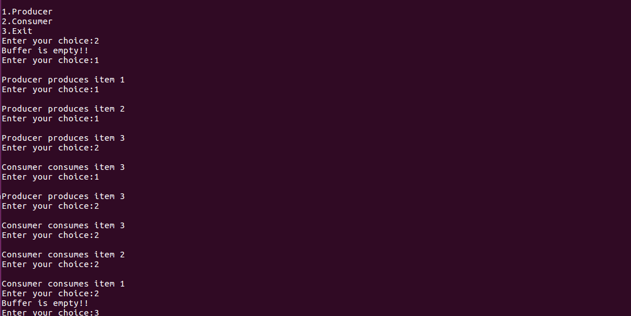生产者-消费者问题是多进程同步问题的一个示例。该问题描述了两个过程,共享公用固定大小缓冲区的生产者和使用者将其用作队列。
- 生产者的工作是生成数据,将其放入缓冲区中,然后重新开始。
- 同时,使用者正在一次消费一块数据(即,将其从缓冲区中删除)。
问题:给定公用的固定大小的缓冲区,任务是确保生产者在缓冲区已满时不能将数据添加到缓冲区中,而使用者不能从空缓冲区中删除数据。
解决方案:如果缓冲区已满,生产者将进入睡眠状态或丢弃数据。消费者下一次从缓冲区中删除项目时,会通知生产者,后者开始再次填充缓冲区。以相同的方式,如果消费者发现缓冲区为空,则可以入睡。生产者下一次将数据放入缓冲区时,将唤醒睡眠中的消费者。
注意:解决方案不足可能导致死锁,这两个进程都在等待被唤醒。
方法:想法是使用并行编程和关键部分的概念,使用OpenMP实现C语言中的生产者-消费者问题。
下面是上述方法的实现:
C
// C program for the above approach
#include
#include
// Initialize a mutex to 1
int mutex = 1;
// Number of full slots as 0
int full = 0;
// Number of empty slots as size
// of buffer
int empty = 10, x = 0;
// Function to produce an item and
// add it to the buffer
void producer()
{
// Decrease mutex value by 1
--mutex;
// Increase the number of full
// slots by 1
++full;
// Decrease the number of empty
// slots by 1
--empty;
// Item produced
x++;
printf("\nProducer produces"
"item %d",
x);
// Increase mutex value by 1
++mutex;
}
// Function to consume an item and
// remove it from buffer
void consumer()
{
// Decrease mutex value by 1
--mutex;
// Decrease the number of full
// slots by 1
--full;
// Increase the number of empty
// slots by 1
++empty;
printf("\nConsumer consumes "
"item %d",
x);
x--;
// Increase mutex value by 1
++mutex;
}
// Driver Code
int main()
{
int n, i;
printf("\n1. Press 1 for Producer"
"\n2. Press 2 for Consumer"
"\n3. Press 3 for Exit");
// Using '#pragma omp parallel for'
// can give wrong value due to
// synchronisation issues.
// 'critical' specifies that code is
// executed by only one thread at a
// time i.e., only one thread enters
// the critical section at a given time
#pragma omp critical
for (i = 1; i > 0; i++) {
printf("\nEnter your choice:");
scanf("%d", &n);
// Switch Cases
switch (n) {
case 1:
// If mutex is 1 and empty
// is non-zero, then it is
// possible to produce
if ((mutex == 1)
&& (empty != 0)) {
producer();
}
// Otherwise, print buffer
// is full
else {
printf("Buffer is full!");
}
break;
case 2:
// If mutex is 1 and full
// is non-zero, then it is
// possible to consume
if ((mutex == 1)
&& (full != 0)) {
consumer();
}
// Otherwise, print Buffer
// is empty
else {
printf("Buffer is empty!");
}
break;
// Exit Condition
case 3:
exit(0);
break;
}
}
} 输出:

想要从精选的最佳视频中学习和练习问题,请查看《基础知识到高级C的C基础课程》。